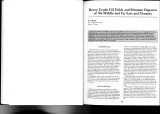TO
| Title | Date | Subject | Description | ||
|---|---|---|---|---|---|
| 1 |
 |
Virtual Radiometers for Parallel Architectures | 2012 | parallel architectures; virtual radiometers; a parallel ray tracing scheme; ray tracing algorithms; radiation; ray tracing; monte carlo; combustion; radiometer; parallel | Background: Parallelization of traditional ray tracing algorithms for radiation applications in participating media suffers from the large amount of inter-processor communication required to hand off rays between processors. As a result, strong scaling of these algorithms falls short of the required... |
| 2 |
 |
On solar thermal processing and retorting of oil shale | 1988-05 | The general concept and a recent paper on solar oil shale retorting are critically reviewed. It is concluded that a recent paper by Berber and Fletcher (Energy 13. 13, 1988) contains erroneously high oil yields and provides no new valid information related to solar oil shale process design or econom... | |
| 3 |
 |
Oil impregnated carbonate rocks of the Timpoweap Member Moenkopi Formation, Hurricane Cliffs area, Utah and Arizona | 1979 | Oil impregnated rocks; Hurricane Cliffs; Utah; Arizona; Timpoweap Member; Triassic Moenkopi Formation; Timpoweap Canyon; Hurricane, Utah | Oil impregnated rocks crop out at several localities near the Hurricane Cliffs in southwestern Utah and adjacent Arizona. The most significant petroliferous deposits occur in the Timpoweap Member of the Triassic Moenkopi Formation in Timpoweap Canyon and the Hurricane Cliffs south of Hurricane, Utah... |
| 4 |
 |
Oil and gas evolution kinetics for oil shale and petroleum source rocks determined from pyrolysis-TQMS data at multiple heating rates | 1991-11 | Evolution kinetics; Oil shale; Petroleum source rocks; Pyrolysis-TQMS data; Programmed-temperature pyrolysis; Triple-quadrupole mass spectrometry; Hydrous pyrolysis | Seven oil shales and petroleum source rocks were subjected to programmed-temperature pyrolysis at heating rates of 1 and 10 °C/min using triple-quadrupole mass spectrometry to monitor volatile compound evolution. Kinetic parameters were determined for evolution of hydrocarbons and various heteroato... |
| 5 |
 |
Oil and gas evolution kinetics for oil shale and petroleum source rocks determined from pyrolysis-TQMS data at two heating rates | 1992-04 | Volatile compound evolution; Oil shales; Petroleum source rocks; Programmed-temperature pyrolysis; Triple-quadrupole mass spectrometry; Hydrous pyrolysis | Seven oil shales and petroleum source rocks were subjected to programmedtemperature pyrolysis at heating rates of 1 and 10 °C/min using triple-quadrupole mass spectrometry to monitor volatile compound evolution. Kinetic parameters were determined for evolution of hydrocarbons and various heteroatom... |
| 6 |
 |
Petroliferous lithosomes in the Moenkopi Formation, southern Utah | 1977 | petroleum; stratigraphic study; southeastern and central Utah petroleum; Moenkopi Formation | Recent stratigraphic studies of the Triassic Moenkopi Formation suggest the possibility of important petroleum potential within the unit in southeastern and central Utah. Potential reservoir rocks include shoreline sandstone in the Black Dragon Member, carbonates in the Sinbad Limestone Member, and ... |
| 7 |
 |
Petroleum geology of the greater Red Wash Area, Uintah County, Utah | 1965-07 | oil and gas field; sandstone; petroleum geology | The Greater Red Wash area is the largest oil and gas field in the Uinta Basin. The Douglas Creek and Garden Gulch Members of the Green River Formation form a lacustrine delta in the area and yield hydrocarbons from a complex network of discrete sandstones. Each individual sandstone body forms its ow... |
| 8 |
 |
Investigation of coal char-slag transition during oxidation: Effect of temperature and residual carbon | 2009 | coal char; molten slag; bitumous coal; energy and fuels | The transition of coal char to molten slag at high conversion was studied for a bituminous coal using a laminar entrained-flow reactor under oxidizing conditions. Post-oxidized char particles were analyzed by various techniques including loss-on-ignition, gas adsorption analysis and scanning electro... |
| 9 |
 |
Green River Formation at Raven Ridge, Uintah County, Utah | 1965-07 | Green River formation; Raven Ridge; sandstone beds; shale; limestone; marlstone; oil-bearing strata | Along Raven Ridge in Uintah County, Utah, exposures of the Green River Formation contain a complex sequence of intertonguing beds of sandstone, shale, limestone, and marlstone. These strata are considered to represent deposition in an orderly sequence of environments from the flood plain through the... |
| 10 |
 |
Geology of the Mill Fork Area, Utah | 1972-12 | geology; Mill Fork area; geologic structure; Green River formation | The Mill Fork area comprises about 70 square miles of Cretaceous ( ? ) and Tertiary sediments at the northern end of the Wasatch Plateau in Utah County, Utah. Over 9000 feet of nonmarine sediments are present and belong to the North Horn, Flagstaff, and Green River formations. These sediments record... |
| 11 |
 |
Heavy-oil and bitumen projects in Madagascar | 1987 | heavy oil; bitumen; Madagascar; Bemolanga tar sand; Tsimiroro heavy crude oil; mining and bitumen-separation operation | Madagascar contains two important deposits, the Bemolanga tar sand and the Tsimiroro heavy crude oil. Although known for years, they have received intensive investigation recently in effort to achieve a measure of energy independence in the face of rising oil costs and dollar-exchange values. The ai... |
| 12 |
 |
Heavy oil production operations in Potiguar Basin, Brazil | 1987 | heavy oil production operations; heavy oil; Portiguar Basin; oil fields; oil | The Potiguar basin is located on the northeastern Brazilian coast and comprises an onshore portion with 21,500 km2 (8300 mi2) and its offshore extension (Fig. 1). In the last 4 years, many oil fields have been discovered in the onshore portion, where today's production reaches 20,000 bbl/d. The oil ... |
| 13 |
 |
Geology and geochemistry of Santa Rosa tar sands | 1987-11-02 | Santa Rosa tar sands; tar sands; heavy oil deposits; Triassic Santa Rosa Sandstone | Heavy oil deposits 11 km (7 mi) north of the town of Santa Rosa, Guadalupe County, New Mexico, in the Triassic Santa Rosa Sandstone, were mined during the 1930s. Renewed interest in this deposit in the late 1970s so far has not resulted in exploitation because of unfavorable economics and the encroa... |
| 14 |
 |
Influence of biodegradation on the chemical composition of heavy oil and bitumen | 1987 | biodegredation; chemical composition of heavy oil and bitumen; heavy oil; bitumen; biodegredation of petroleum | Biodegradation of petroleum is a selective metabolism of special organic compounds by an ensemble of microorganisms. It apparently starts under aerobic conditions, which are provided in areas invaded by surfacederived, oxygen-rich formation waters. Bacteria introduced into an oil pool with meteoric ... |
| 15 |
 |
Light-oils transformation to heavy oils and asphalts-assessment of the amounts of hydrocarbons removed and the hydrological-geological control of the process | 1987 | light-oils; heavy oils; asphalts; assessment; hydrocarbons; petroleum resources; oil alteration | Heavy oils frequently represent a residue left after removal of saturated and aromatic hydrocarbons by various alteration processes. They are characterized by a high content of asphaltenes and polar compounds and by higher sulfur content than the light oils from which they were derived. In the Dead ... |
| 16 |
 |
Major tar sand and heavy oil deposits of the United States | 1985-07 | major tar sand; heavy oil deposits; heavy oil resources; tar sand resources; United States | This paper presents a current assessment of U.S. tar sand and heavy oil resources. It is based on an independent appraisal of all tar sand deposits with 100 million barrels in place or more and the construction of a heavy oil reservoir and data base of fields containing more than 20 million barrels ... |
| 17 |
 |
Geological assessment of heavy-oil reservoirs in the Lloydminster area, using a computerized data base | 1987 | heavy-oil reservoirs; geological assessment; heavy-oil reservoirs; wells | Heavy-oil reservoirs of the Lower Cretaceous Mannville Group in the Lloydminster area (Western Canada) occur in a sequence of complexly arranged sandstones, siltstones, shales, and coals. Trapping mechanisms vary, and the precise geological controls governing hydrocarbon accumulations are not well u... |
| 18 |
 |
Geology of heavy crude oil and natural bitumen in the USSR, Mongolia, and China | 1987 | geology; heavy crude oil; natural bitumen; USSR, Mongolia, China; heavy oil resources; natural bitumen resources | The USSR, Mongolia, and China occupy an area of 33,385,390 km2, or a quarter of the earth's land area. Large reserves and resources of heavy crude oil and natural bitumen are present, especially on the Eastern European (Russian) and Siberian platforms, where at least 700 billion bbl is present (out ... |
| 19 |
 |
Heavy crude oil fields and bitumen deposits of the Middle and Far East and Oceania | 1987 | heavy crude oil fields; bitumen deposits; Middle and Far East and Oceania; oil resource | A total of 119 heavy-oil fields are located in the Middle and Far East and Oceania, in 19 countries. Of these, 12 have ultimate recoveries of more than 500 million barrels, and nine of more than 1000 million barrels. About 97% of the total resource of 120,000 million barrels is found in the Middle E... |
| 20 |
 |
Geology and genesis of the coast range province of California and its hydrocarbon deposits | 1987 | hydrocarbon deposits; tar sand; oil shale | California is along the western borderland of North America where sedimentary deposits accumulated along the eastern Pacific margin. During that time, subduction diastrophism prevailed in the late Mesozoic-early Cenozoic era, and right-lateral strike-slip shear diastrophism prevailed in the middle a... |
| 21 |
 |
Heavy-oil deposit, Great Salt Lake, Utah | 1987 | heavy-oil deposit; Great Salt Lake; Neogene basins | The western portion of the Great Salt Lake contains two large Neogene basins, informally called the "North" and "South" basins. These basins are separated by an arch that trends northeast between Carrington Island and Fremont Island. Both basins are filled with Miocene, Pliocene, and Quaternary sedi... |
| 22 |
 |
An overview of the Chinese UCG program | 2007-08-11 | Coal; China; Underground Coal Gasification; UCG; Two-stage gasification; Chinese UCG program; Energy | Coal is the dominant source of energy in China, but about 50% of the coal resource is left underground unmined. Because of this, the "long-tunnel, large section, two-stage" Underground Coal Gasification (UCG) technology has been put forward, and the UCG model platform has been built. Simulation test... |
| 23 |
 |
Field guide to lacustrine and related nonmarine depositional environments in tertiary rocks, Uinta Basin, Utah | 1976-11 | lacustrine environments; nonmarine depositional environments; tertiary rocks | The lower part of the Tertiary System in the Uinta Basin of northeastern Utah and northwestern Colorado (fig. 1) reflects a series of very complex and variable forms of continental sedimentation in a basin of internal drainage. These complex forms represent the disruption of the Cretaceous depositio... |
| 24 |
 |
Delineation of gas sands by seismic stratigraphy in the Pericocal area, Orinoco Heavy Oil Belt, Venezuela | 1987 | gas sands; seismic stratigraphy; Pericocal area; Orinoco Heavy Oil Belt; deliniation of gas sands; gas sand bodies | The purpose of this study is to define the extent of gas sand bodies found in the Oficina Formation by well SDZ-79X, in the Pericocal area of the Orinoco Heavy Oil Belt. True amplitude processing was applied to 30 km (19 mi) of seismic survey lines in the vicinity of this well. The processing showed... |
| 25 |
 |
Analysis of oil shale and petroleum source rock pyrolysis by triple quadrupole mass spectrometry: Comparisons of gas evolution at the heating rate of 10 °C/min | 1990-10-05 | Kimmeridge; Phosphoria; La Luna; Teistberget; New Albany; Eastern U.S. Devonian; Janusfjellet; Wenzen; Maoming; Fushun; Woodford; Green River; Brotherson; Oil shale; Petroleum; Rock pyrolysis; Gas evolution; Programmed-temperature pyrolysis; Triple-quadrupole mass spectrometry; Mineral matrix; Miner... | Kimmeridge, Phosphoria, La Luna, Teistberget, New Albany, Janusfjellet, Wenzen, Maoming, Fushun, Woodford, and three Green River oil shales were subjected to programmed-temperature pyrolysis at a heating rate of 10 °C/min using triple-quadrupole mass spectrometry as the detection method. Volatile c... |
